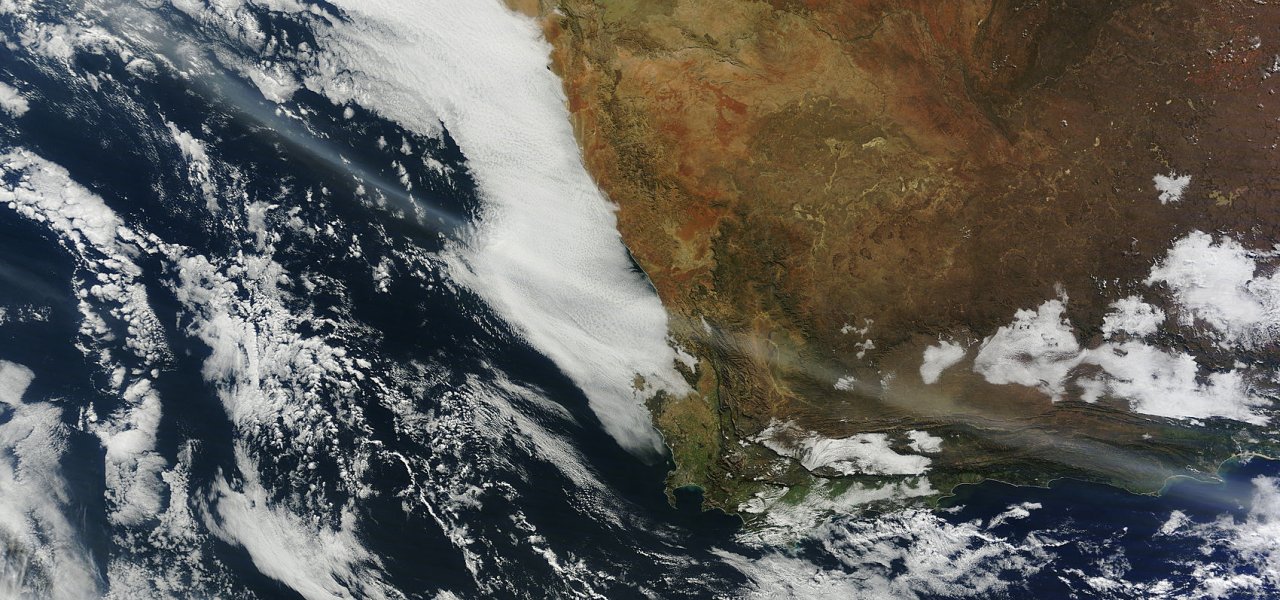If Africa wants to realise its ambitions of a Cape-to-Cairo trade route of bankable renewable energy suppliers, it’s going to need political will that crosses national borders. Last month, the southern continent’s economic bloc SADC announced that it is on track to launch its regional renewable energy strategy next year, writes Leonie Joubert.

South Africa’s inner lands are hardly vertile – but the perfect place to harvest solar energy. (Photo by NASA Goddard/MODIS Rapid Response, Jeff Schmaltz, modified, CC BY 2.0)
‘If you want to farm here, you’d have to have rocks in your head,’ a local water expert once told me, referring to the central and western regions of Southern Africa, which on maps is blocked out in beige to show that it’s mostly near-desert. And he has a point. Parts of this region are so dry that some of the Karoo locals joke that you can only farm with ‘klippe en sand’ (rocks and stones).
But that’s only true if you’re thinking about the conventional forms of farming. If you want to farm with sunlight, then this is precisely where you want to be. Africa has an estimated 20,000 terawatt-hours (TWh) of potential solar power streaming down onto it each year, and yet less than 1 percent of power comes from solar capacity installed across the continent to date.
This is according to the long anticipated Southern African Development Community (SADC) Renewable Energy and Energy Efficiency Status Report, released in Cape Town last month. The report scopes the potential for renewables across the region, and maps out some of the ways that this development bloc can work towards achieving a much greener continent-wide grid. The report comes just a few months after energy ministers here gave the green light to the SADC Centre for Renewable Energy and Energy Efficiency (SACREEE). Based in Namibia, SACREEE will help lubricate green energy rollout by setting up the right policy, training, and investment landscapes, according to the status report.
The priorities, according to the report, are the double-headed challenges of energy security (reliable power and accessible power), and the need for clean, ‘low-carbon’ development. The electricity grid needs to be modernised, expanded to meet demand, and extended to take power into rural communities. At the same time, governments need to grapple with the environmental and health challenges associated with electricity generation – mostly choosing lower-carbon ways of firing the grid, and getting households off polluting forms of energy such as biomass and paraffin burning which lead to significant respiratory problems.
These are the higher level motivations behind the need for this strategy which will see the region’s energy experts trying to rope in the power of hydro, solar, wind, and the likes, to green up the bloc’s grid.
But as the title of the report suggests, rolling out renewables needs to happen in tandem with making the entire sector more energy efficient, including the supplying utility companies, and their distribution grids, and the end-users.
Reading the status report’s review of energy efficiency initiatives by the different SADC countries, it looks as though too much of their attention is on the smaller end-users, rather than on big consumers (like smelters and furnaces in the manufacturing sector, for instance) or on the significant losses along poorly maintained transmission lines.
Across the region, nearly a fifth of all generated electricity leaks out of the system somewhere between power plant and end user – some 19 percent in total, significantly higher than the global average of 8 percent.
But the report says that by far most of the energy efficiency measures are geared towards getting customers to switch from old-school light bulbs to energy efficient CFLs (compact fluorescent light bulbs). The least adopted strategy, says the report, is ‘demand market participation, which requires strong technical collaboration between utilities and their main customers’.
South Africa, for instance, ticks all the boxes in terms of pushing for energy savings at home (educating users about efficiency; subsidising the distribution of CFLs, geyser blankets, and solar water heaters) but gives very little attention to transmission line upgrades, general grid rehabilitation and distribution loss reduction, according to the report.
Nevertheless, this is one of the mandates of the newly minted SADC Centre for Renewable Energy and Energy Efficiency – to promote an approach to energy security that hasn’t been fully adopted by the region.
Whatever happens, if the continent hopes to establish a workable Cape-to-Cairo power grid that’s low-carbon and meets the growing development challenges of the region, it’s going to have to take lofty policy ideals and find effective ways to implement them. This SADC initiative shows that the intention is there to plug this developmental bloc into the continental objective of cleaner, more widely spread and sustainable electricity. Whether the levers of state will make it real, remains to be seen.
Leonie Joubert is a science writer and journalist, and currently works as a fellow with the University of Cape Town’s Environmental Humanities of the South, where she is looking at the political economy of the food system in her country.
Time to criticize.
Author, you live in a different world, some sort of parallel universe.
Go there, live there. And generate beyond the wall.